On face value, Pentax SFX is a fairly big and heavy, first generation autofocus SLR film camera with an obscure user interface, some superfluous features and a strong 1980s design. As such, it might seem that there’s not much to like, but I’ve totally fallen for mine!
The times I find a camera that I really enjoy using are becoming fewer and further between. It’s not that I don’t still get kicks out of the things, but I just don’t get quite as excited about the things as I used to. The funny thing is, what used to motivate my interest not even all that long ago has gone – at least in part – out of the window.
Not so long ago, if you asked me what I thought defined a good camera, I would first tell you that it’s subjective as we all have different needs and tastes. But once a I’d got past telling you that (in a probably fairly self righteous tone), I’d have then gone on to say that my preference was for smaller cameras that have a simple to understand user interface with few, if any, superfluous features.
As I’ve already said, the Pentax SFX is a bigger camera, it has a slightly weird user interface and a couple superfluous features. So what, you might ask, is my attraction? In short, as it turns out, once I got past some of my initial impressions about its user interface, I found it to work for me significantly better than I could have ever expected from such a camera!
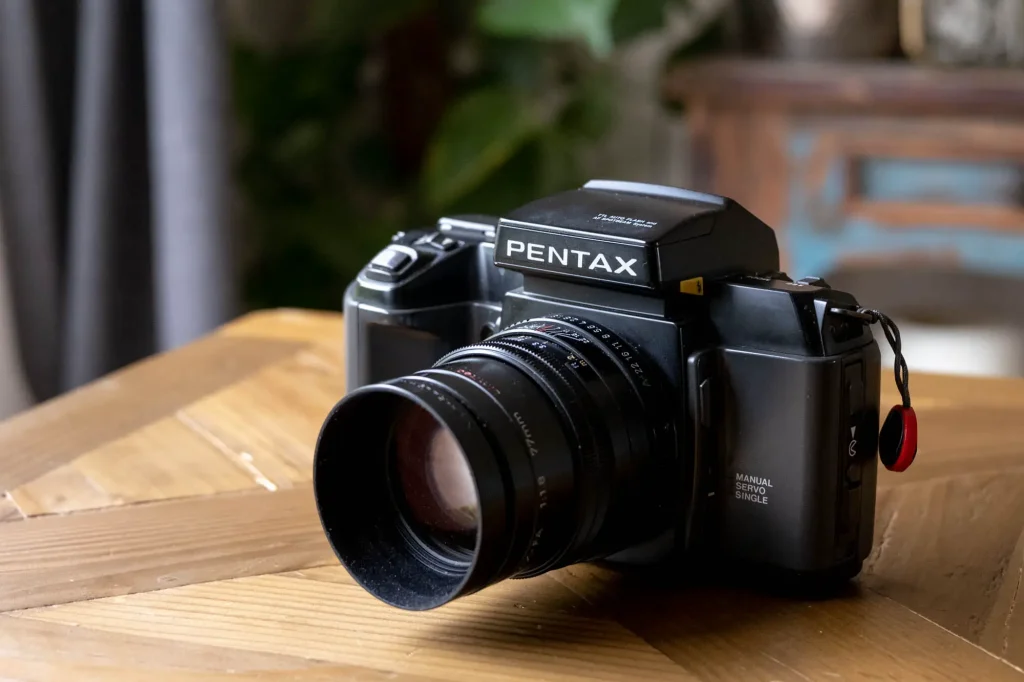
The Beginning
Ok, I’m going to start right at the beginning of my relationship with this camera. In fact, before I get to that, I just need to take you back to before I had even heard of the Pentax SFX. I was digging around for information on AF Pentax cameras and found it on the Pentax forum camera listings. I wrote it off almost immediately as I thought it was ugly, and pretty much concluded that I would never own one.
A Gift
Because of this opinion, when David Allen got in touch with me to tell me he was sending me a gift, had he told me it was a Pentax SFX, I might well have attempted to put him off sending it to me at all. As it was, he didn’t tell me what it was, he simply explained that he had a Pentax camera that he wanted me to try. A few days later I received a fairly heavy box with this brute of a camera in it. Thanks David, I appreciate your sneaky efforts to get this camera into my hands!
First Impressions
It’s fair to say that receiving a camera as a gift will always elevate it’s standing in my collection. This particular Pentax SFX is also in absolutely mint condition, which I suppose helped too. But actually, my first impression was genuinely about 500% more positive than I would have ever expected when regarding a camera like this for the first time.
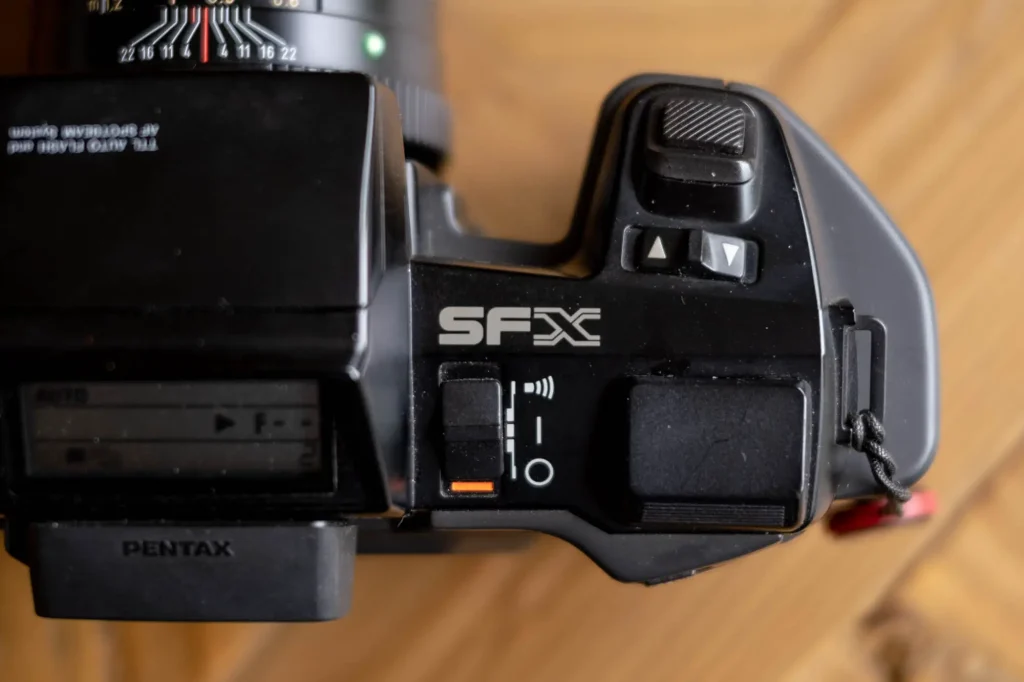
My Pentax SFX has the AA battery grip, I’ve handled it with the standard grip, but with this slightly larger one it fits my right hand perfectly. This thing might look weird with its 1980s shapes, but honestly how it feels in the hand is superb. Actually, call me weird, but in the flesh I found the Pentax SFX to be a much more attractive camera than I thought I might. In fact, this isn’t the first time I have declared my love for an absurdly 1980s looking camera. I also really love the Ricoh FF-70 and 90 Super. As I said in my review of the 70, I think it must be due to the fact that I was born in 83. In my early most impressionable years I would have been surrounded by boxy, angular shaped industrial designs. And I really don’t think there is any denying that these sorts of designs are more interesting than the blobby rounded designs that the 90s brought.
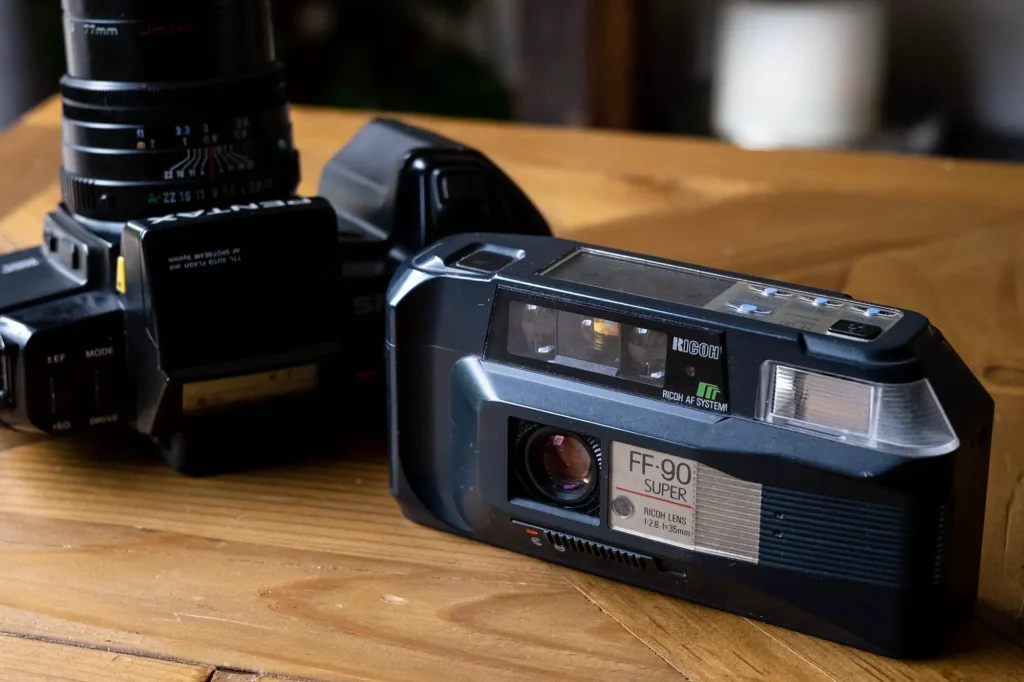
I appreciate I’m not going to convince everyone on that one, but what I think would win most people over is putting the Pentax SFX to their eye. As an autofocus camera, I had fully anticipated a modern focusing screen that wouldn’t be very useful when it came to manual focus lenses. What I found was a huge viewfinder that’s totally clear of markings but for a focusing spot in the middle that is in fact excellent for focusing manual lenses (more on this in a mo).
The Pentax SFX user interface
The Pentax SFX design and viewfinder won me over entirely. That positivity remained until I put batteries in the thing and it almost lost me again. To say the Pentax SFX took a little bit of time to get my head around would be an understatement. It made zero sense to me to begin with. Fortunately, as I’ve alluded, once I got to grips with it I found myself using it with total ease. But it certainly felt like a little bit of a battle to get there.
Buttons and Switches
The Pentax SFX modes and functions are controlled with 3 rocker switches, the aperture dial on the lens, an exposure lock button on the back and a AF/AF-C/MF switch by the lens. It’s actually the aperture control that initially threw me – but I will get to that in a second.
The modes and options are all viewed via the “CENTIC Display” screen that’s unusually positioned on the top of the camera. Since I don’t use flash, and therefore am not going to go into any more detail about it, it’s probably worth me pointing out now that the screen being on top of the camera means the hot shoe is on the right hand side, behind the shutter button and hidden under an awesomely 80s looking hot shoe cover. The Pentax SFX also has a pop up flash.
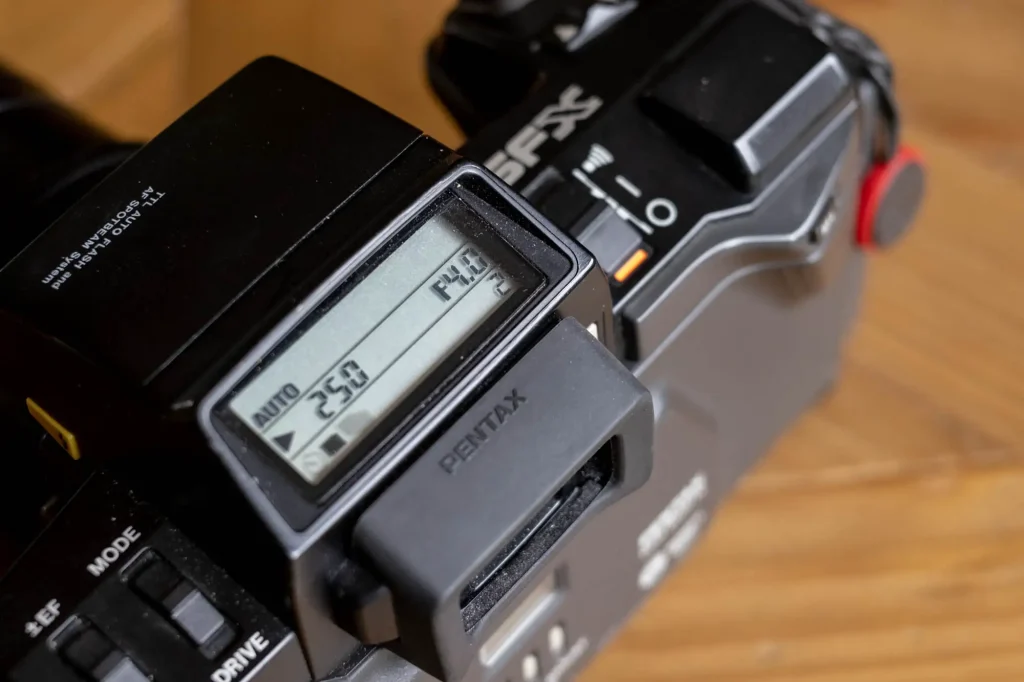
One of the rocker controls – the “Select Switch” is also behind the shutter. This is the rocker that’s used for changing shutter speed, or for changing modes when the other rockers are pushed.
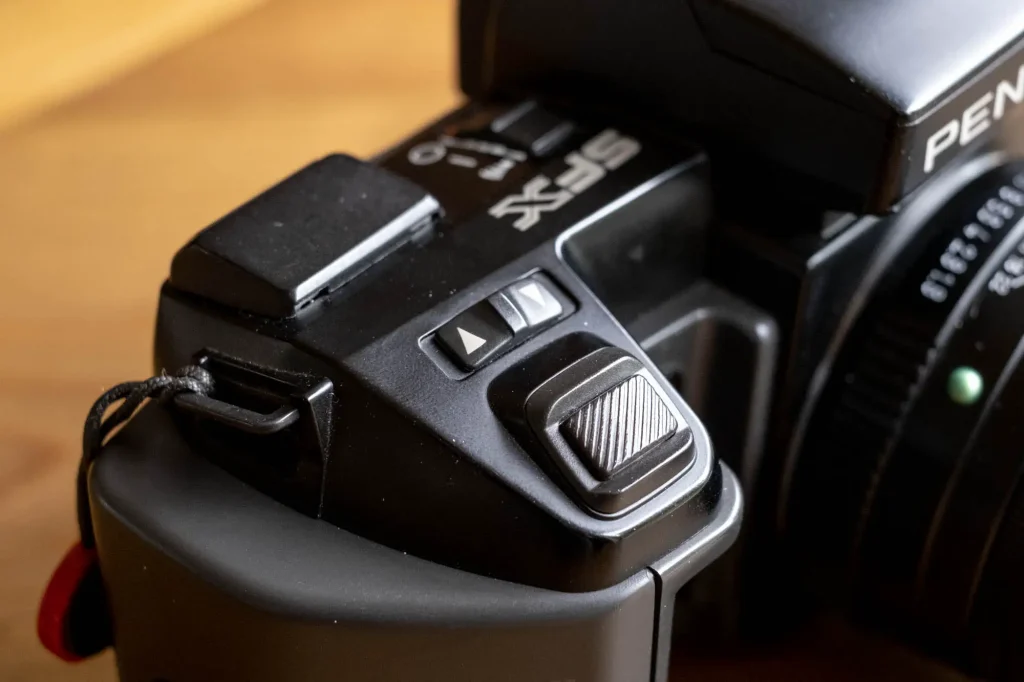
The two other rocker switches are on the left hand side of the camera, one for exposure index (ISO) and exposure compensation and the other for mode and drive. The exposure compensation / index one is simple enough – push and hold it in the direction of the setting you want to change and then change the setting using the rocker on the right hand side. This is the same for the drive setting on the second rocker.
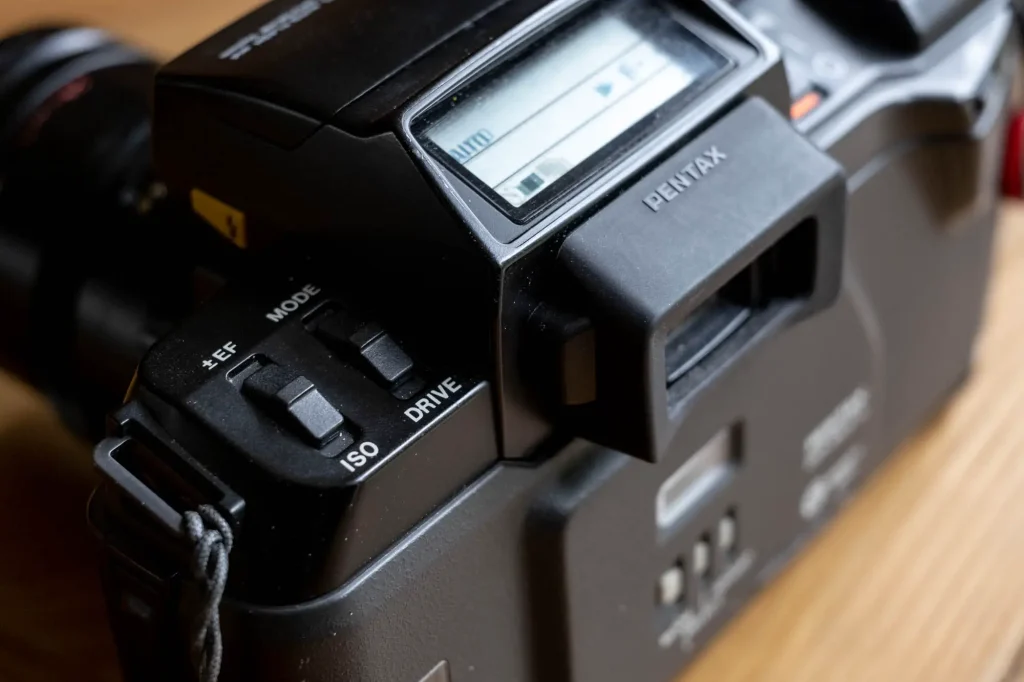
The settings range of these functions is actually pretty good too. The exposure compensation has -/+ 4ev and the exposure index sets from 6 to 6400 ISO. Drive modes are single, continuous and self timer. I haven’t used any of these modes yet.
Shooting Modes
The mode option is where the Pentax SFX made me go a bit crosseyed. What confused me initially was the fact that the selection of modes made available is dependent on how the lens is set. So, if the lens is set to A, when holding the mode button and cycling through the modes, the only modes that are available are 3 varieties of program mode and shutter priority. These slightly superfluous program modes almost entirely put me off the camera – I just don’t need ‘action’ and ‘depth’ priority program modes in my life and they felt like they were getting in the way of me working out how to use the camera.
I also couldn’t work out how the Pentax SFX was set to manual. In fact, it took me flicking through the instruction book to work out that to switch the camera to manual, the lens needed to be switched to manual too – though I suppose that’s quite obvious in hindsight (not least because that’s how all the other AF Pentax SLRs I have work).
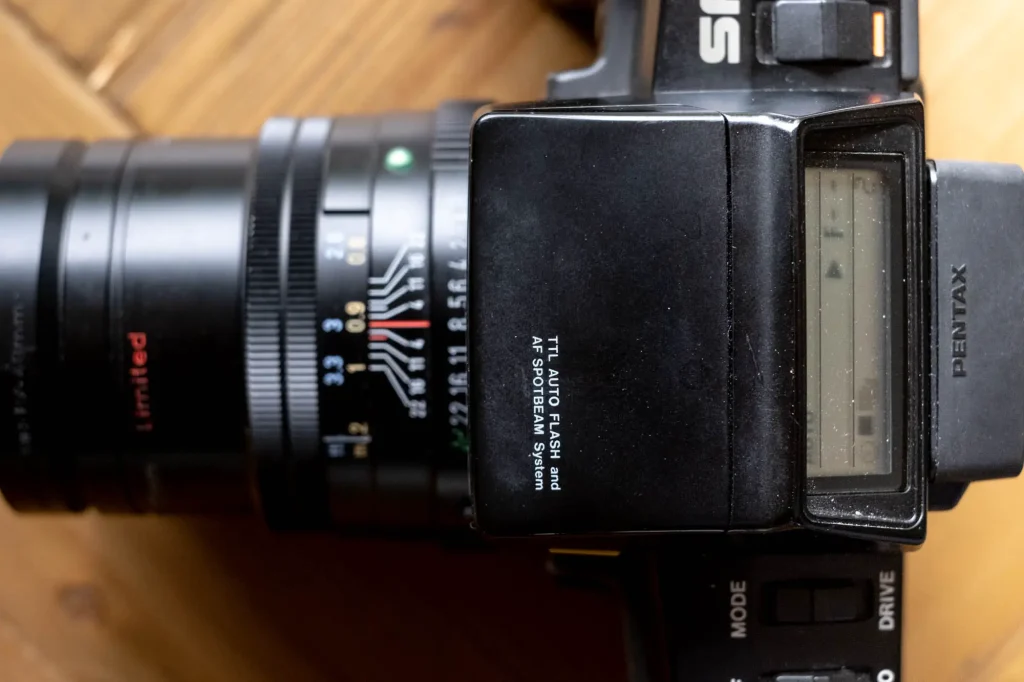
Once the lens is switched to a manual aperture, the contents of the mode option menu changes. The program modes and shutter priority mode disappear and are replaced by a fully manual mode, an aperture priority mode, a “100” mode which locks the shutter speed at 1/100th for flash shooting, and bulb mode. Again, the 1/100 mode and bulb mode aren’t for me, but because the aperture priority and manual modes are next to each other in the menu, it’s very easy to flick between them ignoring the other modes altogether.
Despite this, to begin with, I must admit, I was still a little confused. For some reason, whilst the lens reports the aperture to the camera for display on the little screen when the lens is set to ‘A’, with a manual aperture selected, the screen reports ‘- -‘ where the aperture should be. I wondered to begin with if something was broken, or if it was an incompatibility with my lenses, but after skimming the instruction book, it seems that this is just how it is. If you want to know what aperture the lens is set to, you just have to look at the lens.
Exposure Lock
Apart from the AF/AF-C/MF switch which is self explanatory, the only feature I am yet to mention is the exposure lock. As I’ll come to in a moment, I haven’t really used this as a feature, preferring instead to switch to manual mode instead. Catch me in a different mood or situation to the ones I’ve found myself when using the SFX and I would probably find it very useful.
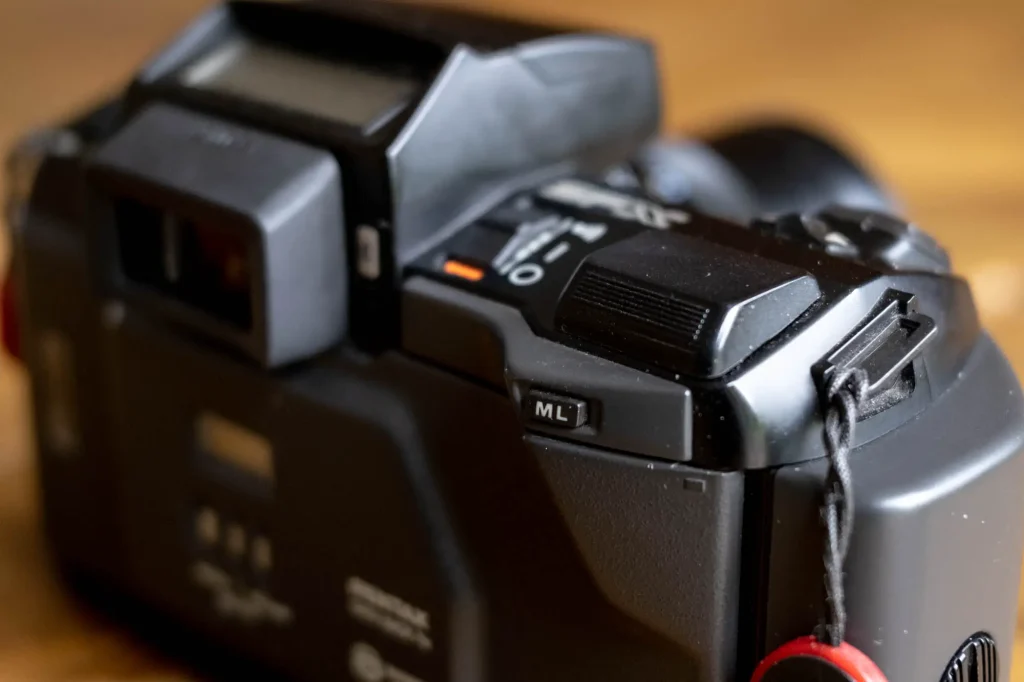
The Pentax SFX has a simple centre weighted meter. It’s the sort that you can shoot fairly confidently with and get decent exposure most of the time. But if you have a high contrast scene and want to expose for a part of it, with the Pentax SFX in one of its AE modes, it’s possible to point the camera around the scene, choose an area you wish to expose for and use the exposure lock button to lock it in until the shot is taken.
The Viewfinder
The only real downside of the aforementioned lack of reporting of set aperture when in manual or aperture priority is that this information is also not shown inside the viewfinder either. Fortunately, this is literally my only criticism of what is otherwise a wonderful view.
As I’ve already said, the viewfinder is huge, and with the Pentax SFX just relying on a centre focusing spot, the view is largely clear of clutter. You can just aim the spot at your target to focus, half press the shutter button to AF, frame and shoot. I find this much easier than faffing with multiple focusing points for essentially everything I do as part of my hobby.
Focus confirmation is also really clear and intuitive. I suppose because the SFX came from the earliest era of AF, Pentax must have been working on the idea that many of their users would still be using manual focus lenses. To this end, whilst the focusing screen doesn’t have a split prism or any other central optical focusing aid, the whole screen pops really nicely when the image is in focus. There’s also a 3 LED system of focus indicators – two red arrows and a green hexagon – that tell you which way to turn the focusing ring and when the subject is in focus respectively. There’s even a beep-when-in-focus mode that can be turned on by flicking the power switch into the second position. Though that’s not to my tastes.
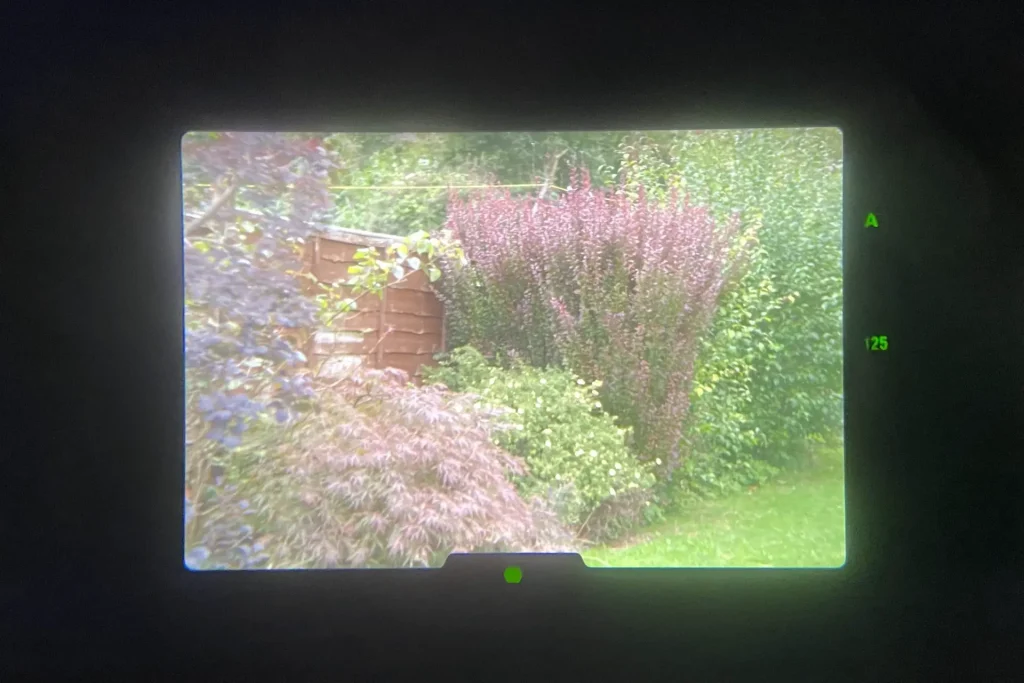
The viewfinder also shows shutter speeds up the right hand side. In auto, the display shows the selected speed, and in manual the selected speed lights up and the required speed flashes. Apart from a couple of mode indicators, that’s all you’ll find in the viewfinder. The simplicity of the information and the size and effectiveness of the view make for quite a compelling user experience.
Noise
Before I get on to a couple of notes about how all this panned out for me in practice, I just want to touch on what I see as the Pentax SFX’s biggest failing. That being the noise it makes. My Pentax 43 and 77mm lenses are both screw focusing lenses so even on quiet cameras they make a sound. But, when on a quiet camera, it is at least just the focusing that’s noisy. On the Pentax SFX, everything is noisy. The lenses are seemingly louder, the shutter make quite the racket and the film advance can’t be described as quiet either. For my holiday snaps, this made no difference to me at all – in fact, I quite enjoyed the archetypal 1980s camera noise it make. If I was shooting a wedding, I don’t think I’d be so comfortable with the racket though!
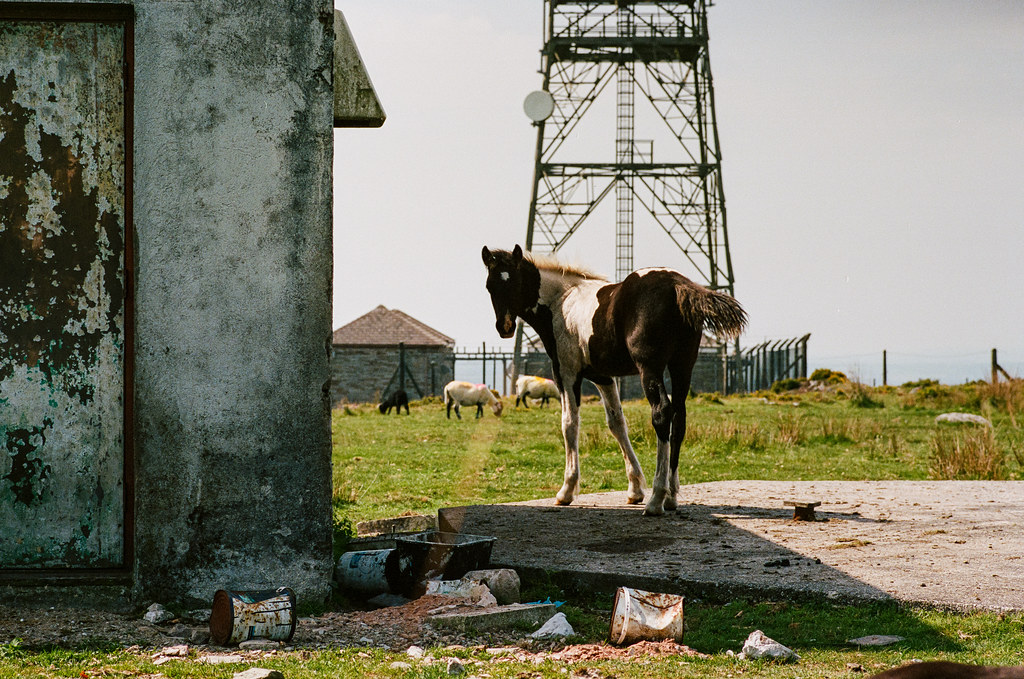
The Pentax SFX in use
The first time I used the Pentax SFX was when visiting Anais to give him his Mamiya 7 back and then for a few shots in my back garden not long after. This shooting experience got me to grips with the camera, but it wasn’t until I shot it on holiday that I really discovered how well it could work for me.
The first day on the holiday I took it to the beach – it was during the recent heatwave we had in the UK so it was very bright, if a little hazy. I suspect anyone who has ever shot a camera on a beach will know that the problems extend beyond the worries of getting sand in the mechanisms. Controlling exposure takes just a little more thought too – specifically when it’s as bright as it was. Both the sea and sand reflect a lot of light, the result of this is that any camera’s light meter will likely combat this by essentially underexposing a little. As such, the way I most frequently shoot on the beach is to revert to Sunny 16.
Given the choice, I otherwise always shoot in aperture priority. So when I got to the beach, that was the mode I had the camera set too. With Portra 400 loaded, I put the camera to my eye and noticed that the exposure was indeed a bit under what I would have expected.
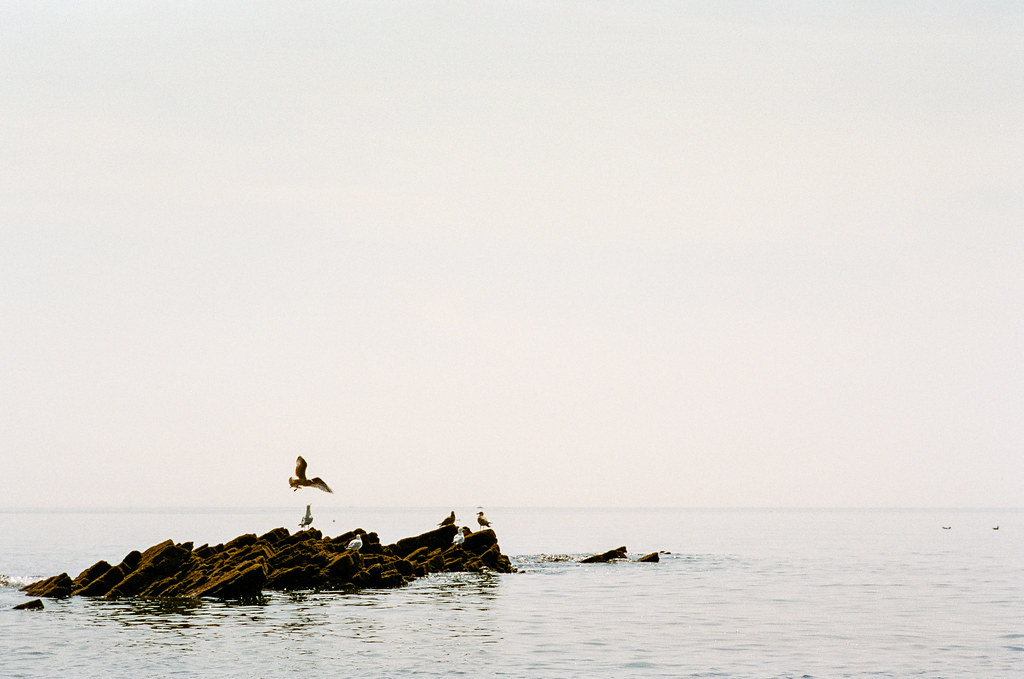
Of course, when everything is bright, there is little point in trying to exposure-lock your way out of the problem, I also didn’t want to be faffing with exposure compensation when I usually just default to Sunny 16. So I just put the camera in manual. Funnily enough, it was making this choice in that moment on the beach that really sealed the deal for this camera and me. It was this moment that I realised that I could quickly flick between aperture priority and manual and essentially everything else in the menu would stay out of my way.
So that was what I did for the whole rest of the holiday. When I was comfortable with the aperture priority meter reading I just let it do its thing, and when I wasn’t, I quickly flicked it into manual. Even within the four rolls I shot, this process became entirely intuitive. Perhaps because of the relative low volume of buttons and switches, or perhaps because I was using the Pentax SFX in such a limited way, my familiarity and comfort with it as a camera came very quickly. I was able to trust its capability based on the roll of shot before I went on holiday, but was also able to master its function to my needs very quickly. There’s very little more I could ask from a camera than this!
Photos
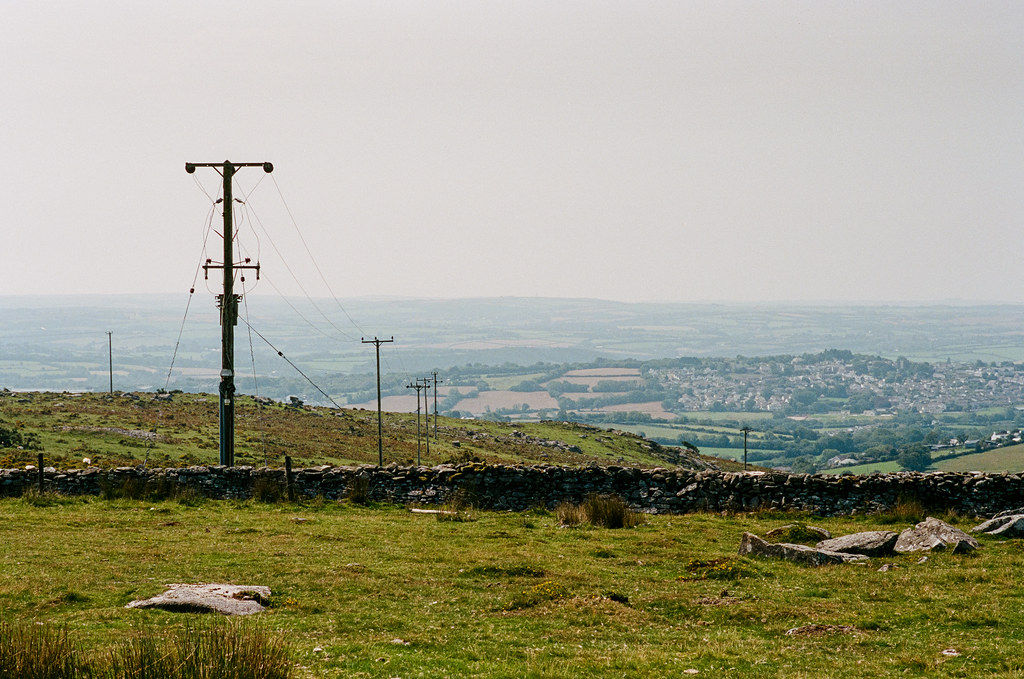

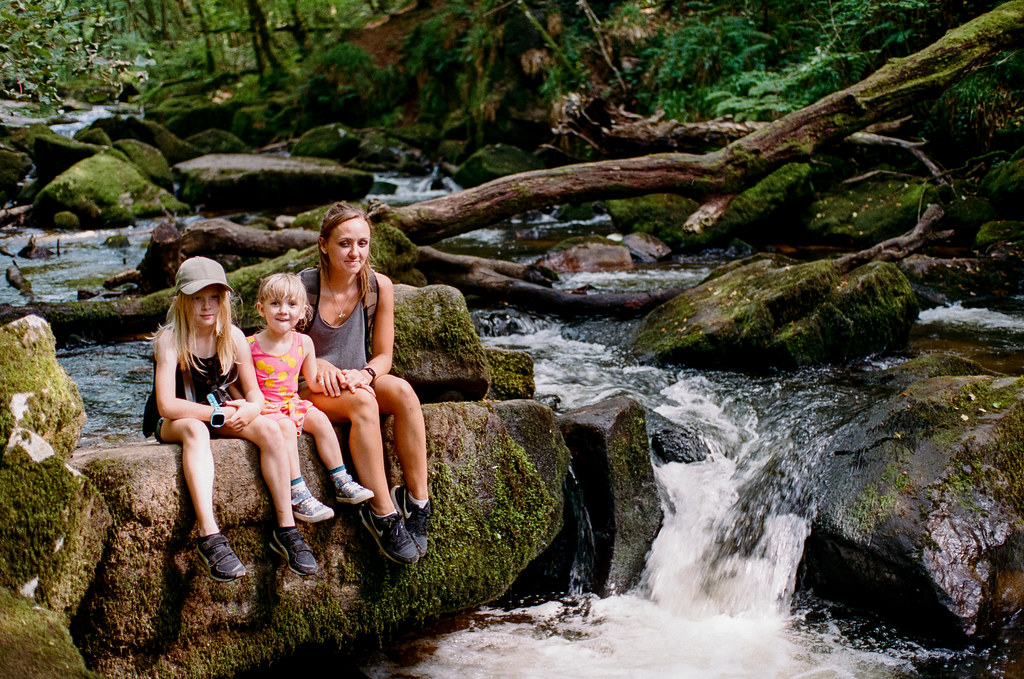
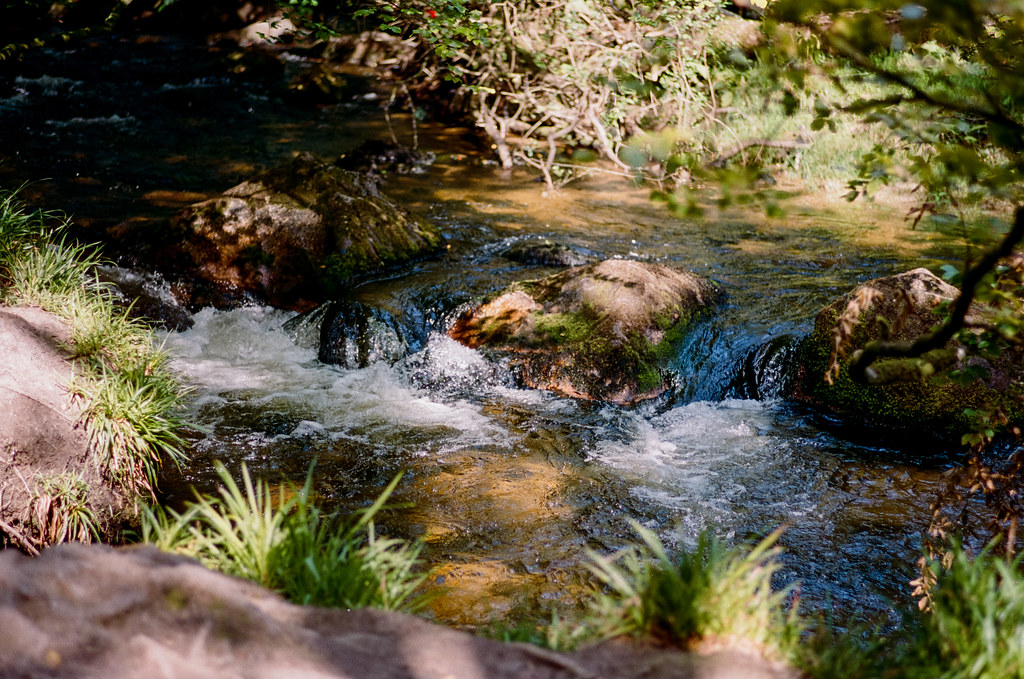
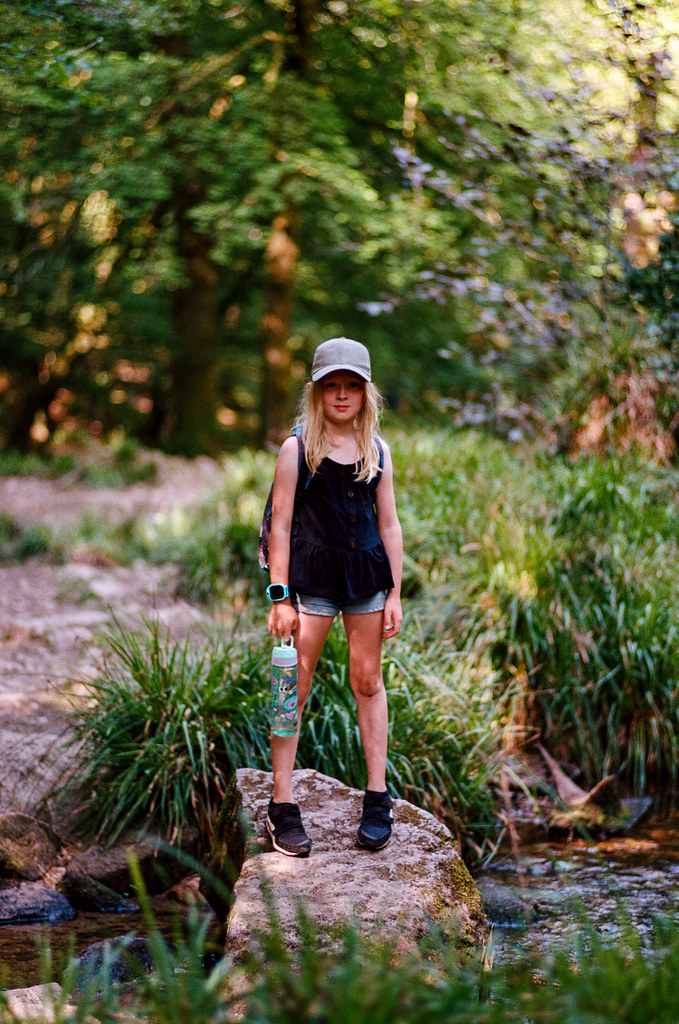



Final thoughts on the Pentax SFX
There is no denying that the Pentax SFX is a bit of an unusual camera. It is without any doubt the sort of camera I would have run a mile from not too long ago. I would have balked at the seemingly odd user interface and the inclusion of the program modes that are of zero use to me.
I have found my ideals in cameras such as my Leica M4-P and Pentax MX that strip away everything but the absolutely essential. As I’ve talked about many times on this website – not least in this article – this is the sort of user experience really chimes with me.
The Pentax SFX on the other hand has more features than I need as a hobbyist photographer. It also has a veneer of complexity that is initially really quite off putting – it nearly ruined the camera for me. But, once I get my head around how it worked, instead of finding myself bogged down by the unusual user interface and superfluous features, I found myself with a camera that somehow just worked for me.
This might perhaps be because it comes from the earliest era of AF SLRs, before manufacturers got themselves bogged down with 100s of options and unnecessary features, or perhaps because it just has so few buttons and switches it’s just inherently easy to control once you find your way with it. Either way, to my continued surprise, the Pentax SFX has really clicked for me. It would have been keeper just for the fact that it was a gift, but in the end, the Pentax SFX has found its way to being my current favourite AF SLR.
Oh, and I haven’t mentioned yet – the Pentax SFX can be picked up for about £30, so it’s a bargain too!
Share this post:
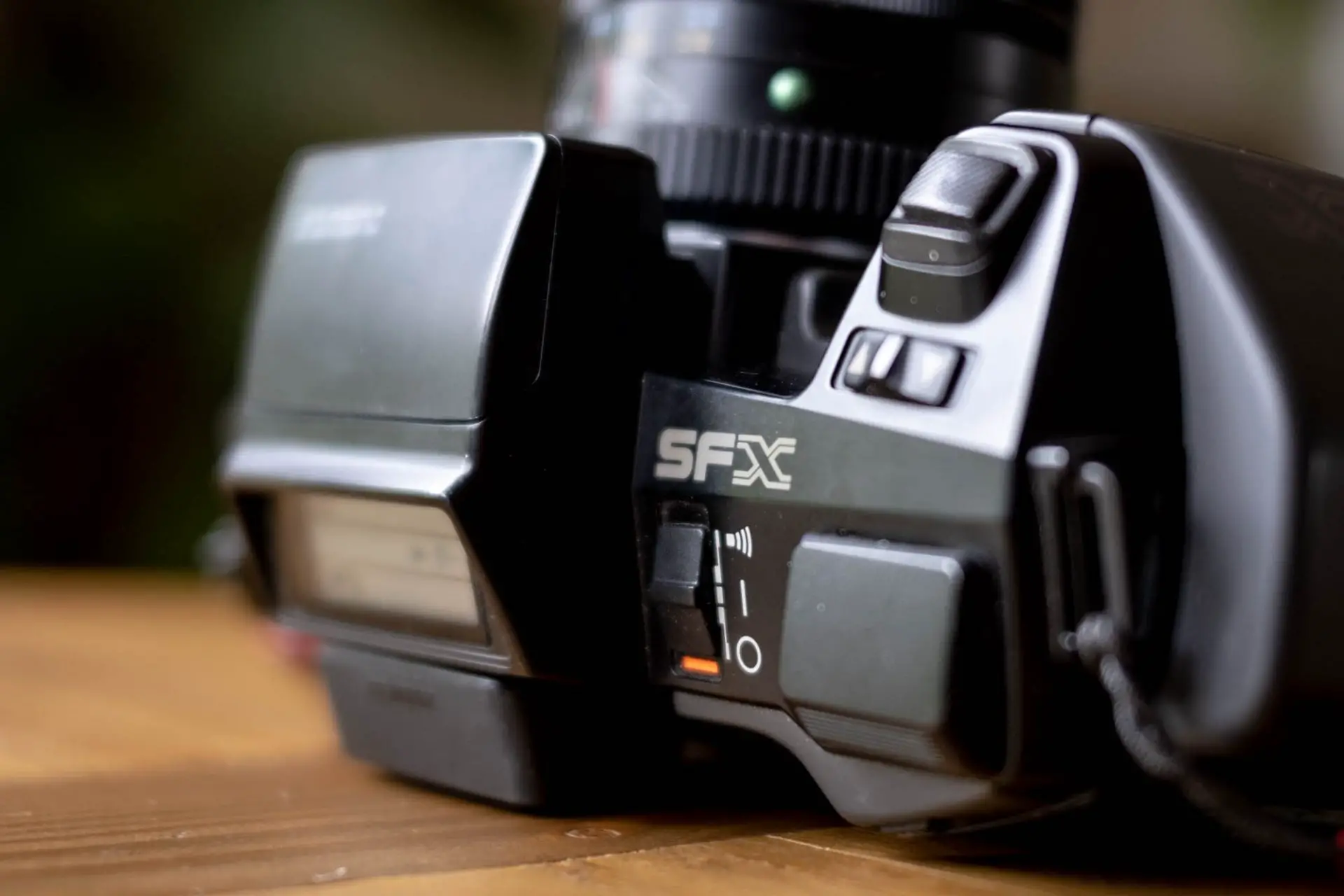








Comments
Jasper on Pentax SFX Review – 1980s First-Gen AF SLR Joy!
Comment posted: 31/08/2020
David Allen on Pentax SFX Review – 1980s First-Gen AF SLR Joy!
Comment posted: 31/08/2020
Comment posted: 31/08/2020
Simon on Pentax SFX Review – 1980s First-Gen AF SLR Joy!
Comment posted: 31/08/2020
Shubroto Bhattacharjee on Pentax SFX Review – 1980s First-Gen AF SLR Joy!
Comment posted: 31/08/2020
Thanks for an informative review.
Do consider changing to an FG-40 grid-screen; it is user-replaceable.
Enjoy the SFX.
Cheers!
Shubroto
Eric Woods on Pentax SFX Review – 1980s First-Gen AF SLR Joy!
Comment posted: 31/08/2020
D Evan Bedford on Pentax SFX Review – 1980s First-Gen AF SLR Joy!
Comment posted: 01/09/2020
Kodachromeguy on Pentax SFX Review – 1980s First-Gen AF SLR Joy!
Comment posted: 01/09/2020
Comment posted: 01/09/2020
Comment posted: 01/09/2020
Comment posted: 01/09/2020
Zhiv on Pentax SFX Review – 1980s First-Gen AF SLR Joy!
Comment posted: 01/09/2020
Comment posted: 01/09/2020
Remy Pascal on Pentax SFX Review – 1980s First-Gen AF SLR Joy!
Comment posted: 01/09/2020
The aperture shows up in with a FA lens on an other setting than A, it still has the big screen on top, and for what you say, the Hyper manual program will work great for you!
Regarding the look of it, well, you disliked the SFX first, and then it's fine. I am expecting the same with the Z1 ;-)
Comment posted: 01/09/2020
Peter Lyons-Lewis on Pentax SFX Review – 1980s First-Gen AF SLR Joy!
Comment posted: 02/09/2020
Anais Faraj on Pentax SFX Review – 1980s First-Gen AF SLR Joy!
Comment posted: 04/09/2020
We have got so used to conventional thinking on what a "good" film camera is that we are blinkered to such gems.
Comment posted: 04/09/2020
Alex G. on Pentax SFX Review – 1980s First-Gen AF SLR Joy!
Comment posted: 06/10/2021
I agree with your remark on the "veneer of complexity". The camera looks more complex and advanced than it actually is. In fact it's very basic, practically a big P&S. It has simplicity (and loudness!) of the Mosin-Nagant rifle :) The only thing it really lacks is the ability to set exact aperture when shooting with aperture ringless lenses. I have to control it indirectly using Action and Depth modes.
The test roll turned out perfectly. I have a much more advanced Pentax Z-1P, but the SF1n certainly has its own charm, and I'm looking forward to using it again. Thanks for the article!
Comment posted: 06/10/2021
Dinah Beaton on Pentax SFX Review – 1980s First-Gen AF SLR Joy!
Comment posted: 10/01/2022
I bought one in excellent condition in Feb 2021 and haven't had the chance to use it fully even though it is loaded with B&W film. Unfortunately though, small problem is that the Pentax-F Zomm 35-70 has to be manually worked at the camera's auto lens function may be stuck. But i'm sure it'll be an easy fix.
Again, thanks for this article, it's and excellent read and very useful.
All the best for 2022
Comment posted: 10/01/2022
sy westfield on Pentax SFX Review – 1980s First-Gen AF SLR Joy!
Comment posted: 17/11/2023
The first time I ran into this camera I was living in Yokohama Japan, teaching English. I saw it on display inside a small camera shop on the 7th floor of the "More" Building in front of Yokohama Train Station.
At that The economy of Japan was "on fire", people were optimistic and their minds were full of dreams of their collective future.
Years ago, When I was knee high, on summer Sundays, my aunts boyfriend often dropped by with camera in hand to click a few black and white photos of me, my brother and my mom on one of the cameras of his growing collection. Around that time the shutter bug must have first stung me.
Anyway, as I played with the camera on that camera stores counter. 3 things impressed me: The large size of the camera makes it comfortable to handle, inspite of being plastic the camera felt substantial and the auto focus was "fast".
My friend in New York, Leighton Perry is a serious film street photographer, I am sure he would like this camera.
Nice to see that you guys have made it easier to leave comments.